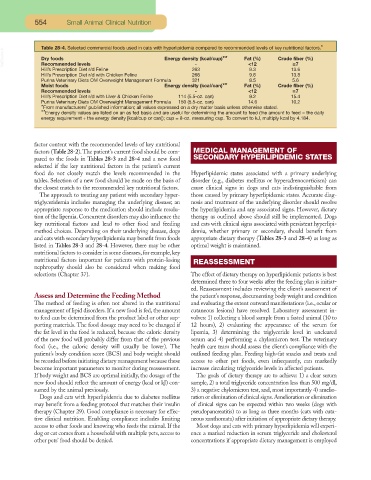Page 536 - Small Animal Clinical Nutrition 5th Edition
P. 536
554 Small Animal Clinical Nutrition
Table 28-4. Selected commercial foods used in cats with hyperlipidemia compared to recommended levels of key nutritional factors.*
VetBooks.ir Dry foods Energy density (kcal/cup)** Fat (%) Crude fiber (%)
≥7
-
Recommended levels
Hill’s Prescription Diet r/d Feline 263 <12 13.6
9.3
Hill’s Prescription Diet r/d with Chicken Feline 266 9.8 13.8
Purina Veterinary Diets OM Overweight Management Formula 321 8.5 5.6
Moist foods Energy density (kcal/can)** Fat (%) Crude fiber (%)
Recommended levels - <12 ≥7
Hill’s Prescription Diet r/d with Liver & Chicken Feline 114 (5.5-oz. can) 9.2 15.4
Purina Veterinary Diets OM Overweight Management Formula 150 (5.5-oz. can) 14.6 10.2
*From manufacturers’ published information; all values expressed on a dry matter basis unless otherwise stated.
**Energy density values are listed on an as fed basis and are useful for determining the amount to feed (the amount to feed = the daily
energy requirement ÷ the energy density [kcal/cup or can]); cup = 8-oz. measuring cup. To convert to kJ, multiply kcal by 4.184.
factor content with the recommended levels of key nutritional
factors (Table 28-2).The patient’s current food should be com- MEDICAL MANAGEMENT OF
pared to the foods in Tables 28-3 and 28-4 and a new food SECONDARY HYPERLIPIDEMIC STATES
selected if the key nutritional factors in the patient’s current
food do not closely match the levels recommended in the Hyperlipidemic states associated with a primary underlying
tables. Selection of a new food should be made on the basis of disorder (e.g., diabetes mellitus or hyperadrenocorticism) can
the closest match to the recommended key nutritional factors. cause clinical signs in dogs and cats indistinguishable from
The approach to treating any patient with secondary hyper- those caused by primary hyperlipidemic states. Accurate diag-
triglyceridemia includes managing the underlying disease; an nosis and treatment of the underlying disorder should resolve
appropriate response to the medication should include resolu- the hyperlipidemia and any associated signs. However, dietary
tion of the lipemia.Concurrent disorders may also influence the therapy as outlined above should still be implemented. Dogs
key nutritional factors and lead to other food and feeding and cats with clinical signs associated with persistent hyperlipi-
method choices. Depending on their underlying disease, dogs demia, whether primary or secondary, should benefit from
and cats with secondary hyperlipidemia may benefit from foods appropriate dietary therapy (Tables 28-3 and 28-4) as long as
listed in Tables 28-3 and 28-4. However, there may be other optimal weight is maintained.
nutritional factors to consider in some diseases,for example,key
nutritional factors important for patients with protein-losing REASSESSMENT
nephropathy should also be considered when making food
selections (Chapter 37). The effect of dietary therapy on hyperlipidemic patients is best
determined three to four weeks after the feeding plan is initiat-
ed. Reassessment includes reviewing the client’s assessment of
Assess and Determine the Feeding Method the patient’s response, documenting body weight and condition
The method of feeding is often not altered in the nutritional and evaluating the extent outward manifestations (i.e., ocular or
management of lipid disorders. If a new food is fed, the amount cutaneous lesions) have resolved. Laboratory assessment in-
to feed can be determined from the product label or other sup- volves: 1) collecting a blood sample from a fasted animal (10 to
porting materials. The food dosage may need to be changed if 12 hours), 2) evaluating the appearance of the serum for
the fat level in the food is reduced, because the caloric density lipemia, 3) determining the triglyceride level in uncleared
of the new food will probably differ from that of the previous serum and 4) performing a chylomicron test. The veterinary
food (i.e., the caloric density will usually be lower). The health care team should assess the client’s compliance with the
patient’s body condition score (BCS) and body weight should outlined feeding plan. Feeding high-fat snacks and treats and
be recorded before initiating dietary management because these access to other pet foods, even infrequently, can markedly
become important parameters to monitor during reassessment. increase circulating triglyceride levels in affected patients.
If body weight and BCS are optimal initially, the dosage of the The goals of dietary therapy are to achieve: 1) a clear serum
new food should reflect the amount of energy (kcal or kJ) con- sample, 2) a total triglyceride concentration less than 500 mg/dl,
sumed by the animal previously. 3) a negative chylomicron test, and, most importantly 4) amelio-
Dogs and cats with hyperlipidemia due to diabetes mellitus ration or elimination of clinical signs.Amelioration or elimination
may benefit from a feeding protocol that matches their insulin of clinical signs can be expected within two weeks (dogs with
therapy (Chapter 29). Good compliance is necessary for effec- pseudopancreatitis) to as long as three months (cats with cuta-
tive clinical nutrition. Enabling compliance includes limiting neous xanthomata) after initiation of appropriate dietary therapy.
access to other foods and knowing who feeds the animal. If the Most dogs and cats with primary hyperlipidemia will experi-
dog or cat comes from a household with multiple pets, access to ence a marked reduction in serum triglyceride and cholesterol
other pets’ food should be denied. concentrations if appropriate dietary management is employed

